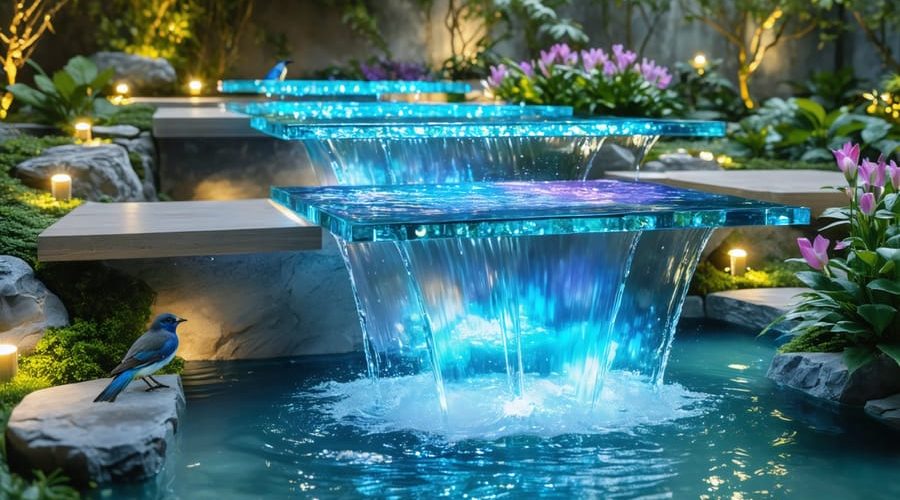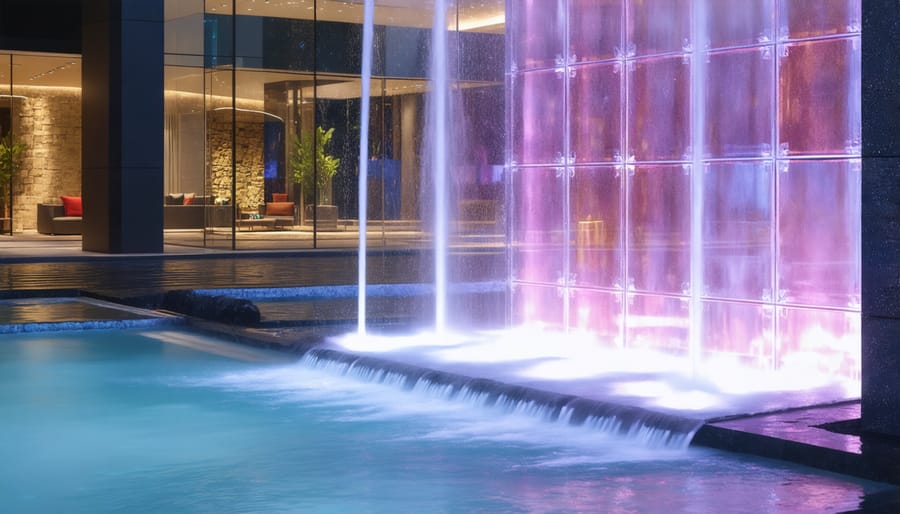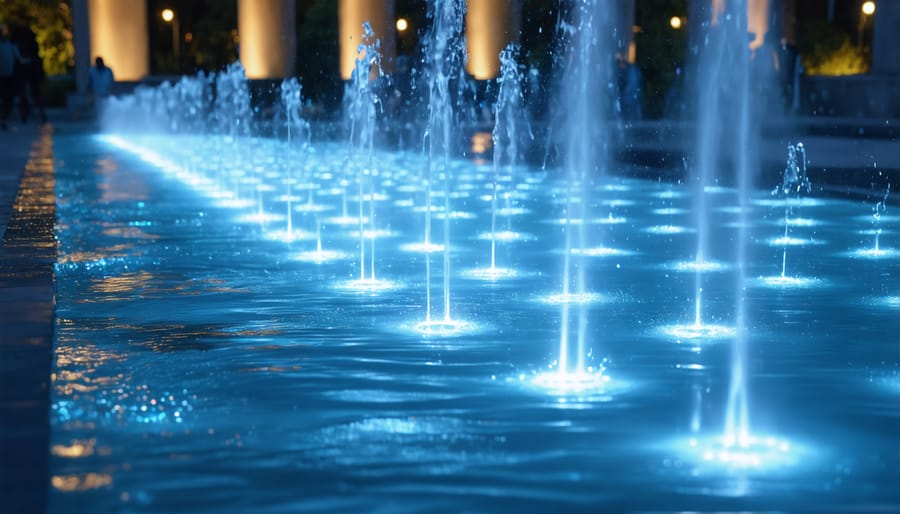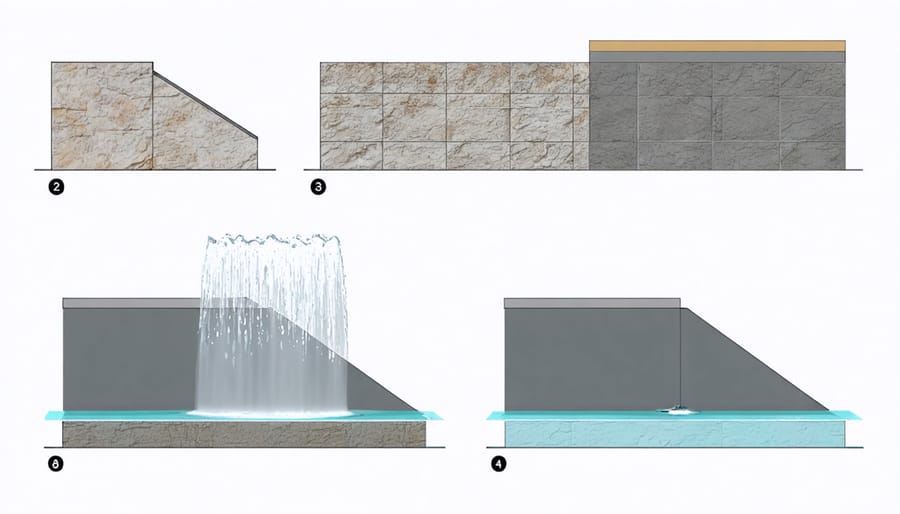
Transform Your Pond into a Stunning Fountainscape (Expert Tips for Every Budget)
Transform your outdoor space into a mesmerizing oasis with the enchanting world of fountainscapes – where flowing water, innovative design, and natural beauty converge to create stunning focal points. Modern fountainscapes have evolved far beyond traditional stone fountains, now incorporating eco-friendly materials, smart technology, and customizable features that make them accessible to both novice gardeners and seasoned landscapers.
From simple tabletop fountains that bring tranquility to your patio, to grand architectural water features that command attention, fountainscapes offer endless possibilities for personal expression and environmental enhancement. These water features not only provide soothing sounds and visual appeal but also attract wildlife, create natural cooling effects, and increase property value.
Today’s fountainscapes merge time-tested principles with cutting-edge materials like recycled composites, LED lighting systems, and solar-powered pumps, making them more sustainable and easier to maintain than ever before. Whether you’re looking to create a peaceful meditation corner, enhance your garden’s ambiance, or make a bold architectural statement, modern fountainscape options can accommodate any vision while working within practical constraints of space, budget, and maintenance requirements.
Revolutionary Materials Reshaping Fountainscape Design
Smart Glass and Light-Reactive Surfaces
One of the most exciting innovations in modern sculptural water elements is the integration of smart glass and light-reactive surfaces. These materials bring an extra dimension of magic to your fountainscape by changing their appearance throughout the day or when they interact with water.
Smart glass panels can transform from clear to frosted with the flip of a switch, creating mysterious veils of water that seem to appear and disappear. When incorporated into fountain walls or backgrounds, these surfaces can alternate between transparency and opacity, adding an element of surprise and delight to your water feature.
Light-reactive tiles and stones are another fantastic option for adding interactivity to your fountainscape. These materials change color when exposed to different temperatures or when water flows over them, creating rainbow-like effects that dance across your fountain’s surface. Some varieties even glow in the dark after absorbing sunlight during the day, turning your evening garden into an enchanted space.
For DIY enthusiasts, there are budget-friendly alternatives like specialty paints and coatings that react to water temperature or create color-changing effects. These can be applied to existing fountain surfaces to achieve similar interactive results without the higher cost of smart glass installations. Remember to choose materials rated for outdoor use and water exposure to ensure longevity and safety in your water feature design.

Eco-Friendly Composite Materials
Today’s eco-conscious water gardeners have exciting alternatives to traditional stone and concrete materials. Modern composite materials offer the beauty of natural textures while being significantly lighter and more environmentally friendly. These innovative materials are typically made from recycled plastics, natural fibers, and sustainable resins, reducing their carbon footprint compared to quarried stone.
One of the biggest advantages of these eco-friendly composites is their durability. Unlike natural stone, they won’t crack in freezing temperatures or deteriorate from constant water exposure. They’re also resistant to algae growth and staining, making maintenance a breeze for busy homeowners.
Weight is another fantastic benefit. Most composite materials are up to 75% lighter than traditional stone, making installation much easier for DIY enthusiasts. You won’t need heavy machinery or extra help to position your fountain pieces, and there’s less stress on supporting structures.
Color options are practically unlimited with these materials. Manufacturers can create authentic-looking stone finishes in any shade you desire, from warm sandstone to cool slate. The colors are also fade-resistant, maintaining their beauty for years without the need for repainting or sealing.
Best of all, these materials are often more budget-friendly in the long run. While the initial cost might be similar to natural stone, their longevity and low maintenance requirements make them a smart investment for any fountainscape project.
Creative Water Flow Solutions
Programmable Water Jets
Programmable water jets have revolutionized modern fountainscapes, bringing a whole new level of creativity and excitement to water features. These smart systems use computer-controlled nozzles that can adjust water flow, direction, and height on the fly, creating mesmerizing patterns and displays that were impossible with traditional fountains.
Picture streams of water dancing in perfect synchronization, changing heights and directions to create shapes, or even spelling out words! These effects are achieved through precise electronic valves and motors that control each individual jet. Most systems come with pre-programmed sequences, but the real fun begins when you start creating your own patterns using user-friendly software.
For homeowners looking to add some pizzazz to their backyard, starter kits typically include 3-5 programmable jets, a control unit, and basic programming capabilities. More advanced setups can incorporate dozens of jets, LED lighting, and even music synchronization for spectacular evening shows.
The best part? These systems are surprisingly energy-efficient. Many use variable-speed pumps that adjust power based on the desired effect, consuming less electricity than traditional constant-flow fountains. They’re also relatively low-maintenance, with self-cleaning nozzles and weatherproof components designed for year-round operation.
Installation does require some technical know-how, especially for electrical connections and programming. While DIY installation is possible for basic systems, it’s worth consulting a professional for complex setups. They can help ensure proper placement, water pressure, and electrical safety while teaching you how to program and maintain your new water feature.
Just remember to check local regulations regarding water features and electrical installations before starting your project. Some areas have specific requirements for outdoor water displays and lighting.
LED-Integrated Water Features
LED technology has revolutionized the way we think about water features, creating stunning magical night displays that combine the soothing sounds of flowing water with captivating light shows. These integrated systems offer endless possibilities for transforming your outdoor space into an enchanting retreat after sunset.
Modern LED-integrated fountains come with color-changing capabilities, allowing you to set the perfect mood for any occasion. Whether you’re hosting an outdoor dinner party or simply enjoying a peaceful evening in your garden, you can easily switch between calming blue hues, romantic purples, or festive multicolor displays with just a touch of a button.
What makes these features particularly appealing to homeowners is their energy efficiency and durability. LED lights consume significantly less power than traditional halogen bulbs and can last up to 50,000 hours. They’re also completely waterproof and safe to use in fountain systems, requiring minimal maintenance throughout the year.
Installation is surprisingly straightforward, with many systems offering plug-and-play functionality. You can choose from submersible LED rings that illuminate water from below, edge-mounted strips that create dramatic cascading effects, or floating options that dance on the water’s surface. Some advanced models even synchronize light patterns with water movement, creating dynamic displays that respond to the flow of your fountain.
For DIY enthusiasts, many manufacturers now offer complete kits that include everything needed for installation, from the LED fixtures to waterproof connectors and simple programming interfaces. This makes it easier than ever to add this stunning feature to your existing fountainscape or incorporate it into a new design.

DIY-Friendly Installation Tips

Surface Preparation Techniques
Before installing your fountainscape, proper surface preparation is essential for long-term stability and beauty. Start by clearing the intended area of any vegetation, rocks, or debris. Level the ground using a shovel and rake, then compact the soil with a plate compactor or hand tamper to create a solid foundation.
For concrete surfaces, thoroughly clean the area with a pressure washer to remove dirt, algae, and loose materials. Fill any cracks or holes with appropriate concrete patching compound and allow it to cure completely. If you’re working with existing pavers or stones, ensure they’re firmly set and level, adjusting as needed with sand or gravel underneath.
When installing a water feature on soil, lay a 2-inch base of crushed stone or gravel, tamping it down firmly. This helps with drainage and prevents settling. Next, add a layer of sand approximately 1 inch thick, leveling it carefully with a straight edge.
For all installations, use a high-quality pond liner or rubber membrane to prevent water seepage. Extend the liner beyond your fountain’s footprint by at least 12 inches on all sides. Place protective underlayment beneath the liner to guard against punctures from sharp stones or roots.
Remember to create a slight slope away from any buildings or structures to ensure proper drainage. This gentle grade, about 1 inch per 8 feet, will help direct excess water away from your home’s foundation.
Maintenance Requirements
Regular maintenance is key to keeping your fountainscape beautiful and functioning properly. Start with a weekly cleaning routine to remove debris like leaves, twigs, and any buildup. Using a gentle net or skimmer, clear the surface and check the pump intake for blockages.
Monitor water levels every few days, especially during hot weather when evaporation increases. Top up as needed with clean, dechlorinated water to protect your pump and maintain proper flow. Check water quality monthly using simple test strips to ensure proper pH balance and prevent algae growth.
Your pump requires quarterly maintenance – remove it carefully, clean all components, and check for wear. Replace any worn parts promptly to prevent system failure. In winter, either run your fountain continuously to prevent freezing or drain and store components indoors if temperatures regularly drop below freezing.
For stone and concrete features, inspect annually for cracks or damage. Seal these materials every two years to prevent water damage and extend their life. LED lights should be checked monthly for proper operation, and electrical connections should be inspected for any signs of wear or exposure.
Keep a maintenance calendar to track these tasks, and you’ll enjoy your fountainscape for years to come. Remember that prevention is always easier than repairs, so staying on top of basic maintenance will save you time and money in the long run.
Cost-Effective Alternatives
Creating beautiful fountainscapes doesn’t have to break the bank. With some creative thinking and smart material choices, you can achieve stunning water features on a budget. Start by considering repurposed items like old watering cans, ceramic pots, or vintage buckets as fountain bases. These items add character while significantly reducing costs compared to pre-made fountain structures.
For a modern twist, consider using PVC pipes to create multiple water spouts. Paint them with weather-resistant coating to match your garden’s aesthetic. Stack river rocks or recycled concrete pieces to form natural-looking organic water features that cost a fraction of store-bought options.
Solar-powered pump systems are excellent money-savers in the long run. While the initial investment might be slightly higher, you’ll save significantly on electricity costs. Look for smaller, efficient pumps that match your feature’s size – bigger isn’t always better, and proper sizing can save both energy and money.
Container water gardens offer another budget-friendly approach. Use sturdy plastic containers or repurposed wooden barrels, seal them properly, and add small floating fountains. These portable solutions create lovely water movement without extensive installation costs.
Consider using locally sourced materials like native stones and recycled glass for decorative elements. Many landscape supply yards offer remnant pieces at discounted prices. For lighting, opt for solar-powered LED lights instead of wired systems – they’re easier to install and maintain.
Remember that simplicity often creates the most striking effects. A single, well-placed water spout can be just as impactful as multiple elaborate features. Focus on quality construction and proper installation rather than size or complexity. This approach ensures longevity while keeping costs manageable.
Creating a fountainscape is more than just adding a water feature to your outdoor space – it’s about crafting a personal oasis that brings joy, tranquility, and natural beauty to your everyday life. As we’ve explored throughout this guide, fountainscapes offer endless possibilities for creativity and self-expression, whether you’re working with a small balcony or a sprawling backyard.
Remember that successful fountainscapes start with thoughtful planning, considering factors like space, budget, and maintenance requirements. From simple tabletop fountains to elaborate multi-tiered displays, there’s a perfect water feature waiting to enhance your outdoor living area. The key is choosing elements that reflect your personal style while remaining practical for your specific situation.
Don’t feel overwhelmed by the process – start small if you need to, and allow your fountainscape to evolve over time. The beauty of these water features lies in their flexibility and adaptability. You can always add new elements, adjust the design, or upgrade components as your confidence and expertise grow.
Ready to begin your fountainscape journey? Take that first step today by selecting your ideal location and starting with a basic design. The soothing sounds of flowing water, the visual appeal, and the natural habitat you’ll create will reward you many times over. Remember, every magnificent water garden started with a single feature – yours could be next!
